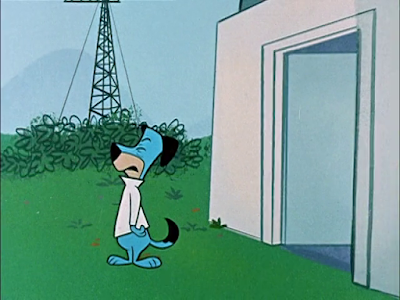This is the one with the megalomaniac potato that tries to take over the Earth. Huck traps him in a “spud-nik” that orbits the planet. Our hero advises us the potato is in a dangerous situation because the rocket could explode. Suddenly, a blast sound effect and black and white cards appear on the screen to simulate an explosion. This kind of thing was done in theatrical cartoons, too.



This is followed by a glowing effect, kind of like a glazing. There are several different versions of brightness; here are three of them.




As I’m not a cartoon director nor a cameraman, I don’t know if they opened up the aperture to allow more light in or used an airbrush to make this visual effect. I believe this was the final time the studio tried this.

My guess on how they did this would be that they got a separate cel for the airbrush, and for the "glowing", they probably messed with the exposure.
ReplyDeleteAhhh, the Giant Spud's death that leads to potato chips raining from the sky. From one of my favorite "Huckleberry Hound" episodes.
ReplyDeleteYes! One of my favorites. Had some good lines, also.( After the rocket explosion ) " Well, we'll never know for *sure* what happened....but...uh... it is rainin' potater chips.."
ReplyDeleteThey sometimes used frosted cels (cels with a translucent, rough white coating as an overlay cel for this type of effect, wiping the surface to remove the "frosted" coating, and leaving some of the coating behind. A pencil drawing of Huck with the background would be highlighted with a colored pencil over the areas where they would want the effect to show. The frosted cel would then be placed over this drawing and then the wiping out would begin.
ReplyDeleteTo get a varying effect of the blast over the character cel/background, this held cel/bg would be underexposed by a certain percentage, let's say 60%. The prepared frosted cel would then be placed over the same character cel/bg and exposed for the remaining 40% for your "camera effect." These exposure settings would then be made to vary over the number of frames the held cel/bg would last on the screen. If, for example, held for 48 frames, they could get away with exposing each combination for up to 4 frames, altogether 12 separate exposures (4 frames each, and would have to do this for both the character cel/bg and the frosted cel as separate camera passes. HB may have done this differently, but in my animation experience, this is how we did it back in the days of glorious hand-drawn cel animation. Thanks for the post Mr YOWP. Your site is my favorite daily go-to, bringing back many a fond memory.
I hate begging.
ReplyDeleteBut LAF-2-12 ON THE RUN (Shaindlin) when?